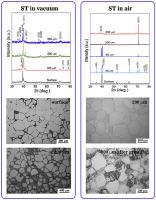当前位置:
X-MOL 学术
›
Prog. Nat. Sci. Mater. Int.
›
论文详情
Our official English website, www.x-mol.net, welcomes your feedback! (Note: you will need to create a separate account there.)
Microstructural evolution in the surface of Ti–10V–2Fe–3Al alloy by solution treatments
Progress in Natural Science: Materials International ( IF 4.7 ) Pub Date : 2020-02-01 , DOI: 10.1016/j.pnsc.2020.01.011 Lichun Qi , Kaichao Zhang , Xueliang Qiao , Lijun Huang , Xu Huang , Xinqing Zhao
Progress in Natural Science: Materials International ( IF 4.7 ) Pub Date : 2020-02-01 , DOI: 10.1016/j.pnsc.2020.01.011 Lichun Qi , Kaichao Zhang , Xueliang Qiao , Lijun Huang , Xu Huang , Xinqing Zhao

|
Abstract By solution treatments in vacuum and in air, the surface region of Ti–10V–2Fe–3Al exhibits different microstructures from the interior region of the alloy. When solution treated in vacuum, the microstructure of the specimen is composed of dominant β phase and a few of α″ martensite in surface region, with a large amount of α″ martensite and a little of β phase in interior. When solution treated in air, the specimen is characterized by dominant surficial α phase and interior β phase. In addition, the lattice parameter evolutions of α and β phases were observed in the surface region of the specimens by solution treatment in air. The mechanism for the surface effects is discussed in light of the structural stability and phase evolution in Ti–10V–2Fe–3Al alloy with solution treatments.
中文翻译:

固溶处理 Ti-10V-2Fe-3Al 合金表面显微组织演变
摘要 通过真空和空气中的固溶处理,Ti-10V-2Fe-3Al 的表面区域呈现出与合金内部区域不同的微观结构。真空固溶处理时,试样的显微组织由表面区占主导地位的β相和少量α″马氏体组成,内部有大量α″马氏体和少量β相。在空气中进行固溶处理时,试样的特征是表面α相占主导,内部β相占优势。此外,通过在空气中进行固溶处理,在样品的表面区域观察到 α 和 β 相的晶格参数演变。根据固溶处理的 Ti-10V-2Fe-3Al 合金的结构稳定性和相演变,讨论了表面效应的机制。
更新日期:2020-02-01
中文翻译:

固溶处理 Ti-10V-2Fe-3Al 合金表面显微组织演变
摘要 通过真空和空气中的固溶处理,Ti-10V-2Fe-3Al 的表面区域呈现出与合金内部区域不同的微观结构。真空固溶处理时,试样的显微组织由表面区占主导地位的β相和少量α″马氏体组成,内部有大量α″马氏体和少量β相。在空气中进行固溶处理时,试样的特征是表面α相占主导,内部β相占优势。此外,通过在空气中进行固溶处理,在样品的表面区域观察到 α 和 β 相的晶格参数演变。根据固溶处理的 Ti-10V-2Fe-3Al 合金的结构稳定性和相演变,讨论了表面效应的机制。



























 京公网安备 11010802027423号
京公网安备 11010802027423号